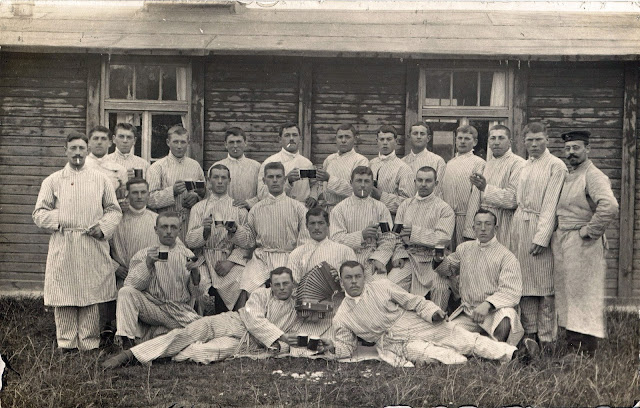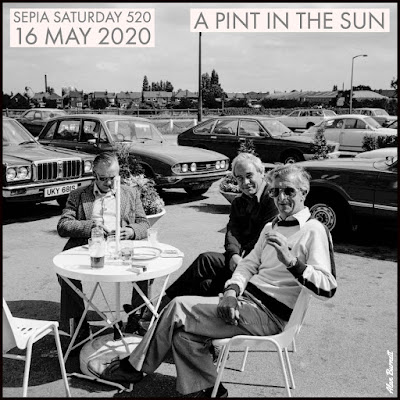Beer.
It can make a young man wise
and an old man foolish.
It can make a young man wise
and an old man foolish.
With enough lager
a shy man will sing
and a brave man may cry.
a shy man will sing
and a brave man may cry.
Whether sharing a pint, or a litre,
good ale inspires songs of life
and stories of old friends.
good ale inspires songs of life
and stories of old friends.
One of the curious sub-genres of photographs
in my collection are postcard photos
of small groups of military servicemen
enjoying an off-duty "relaxed" moment
with their mates.
The majority of these photos
are of soldiers and sailors
from the time of the German Empire,
often posed as if
they were in a pub or cafe garden
savoring a glass of beer
while listening to a musical comrade.
in my collection are postcard photos
of small groups of military servicemen
enjoying an off-duty "relaxed" moment
with their mates.
The majority of these photos
are of soldiers and sailors
from the time of the German Empire,
often posed as if
they were in a pub or cafe garden
savoring a glass of beer
while listening to a musical comrade.
Today I have three photos
on this theme
to exhibit.
on this theme
to exhibit.
The first image was clipped from a postcard photo of a group of German soldiers seated in a photographer's studio that is staged to look like a romantic forest beer garden. Arranged around a small table are ten soldiers, most holding beer steins. Two enlisted men sit on the "ground" floor strumming two musical instruments. One has a pear-shaped mandolin and the other a similarly shaped but larger lute-guitar. They are the only men whose regiment numbers, 23 and 70. are visible on their shoulder bars. One soldier wears a distinctive Pickelhaube headgear of the Imperial German Army. His helmet plate or Wappen is an eagle, the symbol of a Prussia soldier, but the spike on top is not pointed. Instead it is a round knob that signifies an artillery regiment. The small table has a card with the number 144 which may be connected to their army division. I don't think any of the soldiers are bandsmen, but are just regular enlisted men.
The soldiers' expressions are a bit wistful, even melancholy, as if this was their last round before closing time. While the mandolin and lute-guitar might be studio props, the two men seem to hold them expertly enough. Musical instruments appear so frequently in soldiers' photos like this that I think they represent the German love of music. It's as if the men are sharing a song and a beer with the distant recipient of the postcard.
The postcard was sent from Saarbrücken on 10 July 1910 to a Fräulein Zimmer(?) in P...(?) Rhineland(?). Saarbrücken is located in western Germany, right on the chin of the border with France. However in 1910 it was several kilometers inland of the western region of Alsace-Lorraine which was then part of the German Empire.
* * *
The second clip shows another group of eight German soldiers with beer steins, this time outside under a striped pole with a sign that reads: Nach der Heimat noch 175 Tage ~ 175 days after home. One solider is astride a wooden hobbyhorse and brandishes a short sword. Next to him is a cutout figure of a smiling ape drinking a frothy glass of beer while sitting on a keg. Presumably the mascot of the brewery. On a slate in front is another sign that reads: Treue Freundschaft beim Commiss geht über jedes Hinderniss ~ Loyal friendship at the Commiss(?) goes beyond every obstacle.
But on the left is a soldier seated with a simple accordion or concertina. At his feet is a slate that reads: Nun seht bles diese alten Knochen, die haben nur noch 25 Wochen. Reserve 1914 ~ Now just see these old bones, they only have 25 weeks left. Reserve 1914. This better explains the reason for their celebration. The soldiers are serving their year of military obligation, maybe in basic training, and look forward to going home soon.
But before those next 25 weeks finish the men will wish they were back in the beer garden. The soldiers' postcard was sent from Darmstadt, Germany on 25 March 1914. In less than 18 weeks they will be marching through Belgium on a line to Paris.
* * *
The third image shows a concertina player knelling in the center of a group of 23 men dressed in striped pajamas and holding beer steins. They are German soldiers too, but their casual attire is the uniform of a wounded warrior. One soldier on the far right wears a long apron and I think he is a medical orderly. The picture was taken at the Reservelazarett or Reserve hospital in, appropriately enough, Weingarten, Württemberg. The postmark is dated 29 November 1915, nearly one year and three months since the beginning of the Great War.
There are few smiles on the faces of these men. They look reasonably fit and whole, and probably expect to return to duty soon. All the more reason to enjoy a glass of beer with their mates. The bonds of friendships during wartime are like no other.
Over the past few weeks of self-quarantine, my wife and I watched the series of seven Harry Potter films. My wife, a big fan of J. K. Rowling's novels, had recently re-read them and wanted to conclude with the complete cinematic experience. However, I have different literary interests and have not read the books, but I will grant that the movies are exciting and distracting enough with their complicated fantasy stories and imaginative characters.
But after seeing the films again in close succession I was struck by J. K. Rowling's theme of memory that connects the series. In Harry Potter's struggle against the evil Lord Voldemort, he encounters several magical devices that reveal old memories, often linked to love and friendship. It's a similar notion to a talisman, an object imbued with secret human feelings and actions known only to the bearer.
These photographs of German soldiers are also mysterious devices of memory, charmed with hidden powers of remembrance. How did they manage to be preserved for over 100 years though times of war and revolution? What names and stories were recalled by these photos? Who protected these postcards, safeguarding the simple messages on the back for posterity?
We can never know the true meaning of these images, but like the fictional Harry Potter learned, the most powerful magic is found in friendship and love. In the end those are the enchantments preserved in these photos that will always overcome hatred and misery.











6 comments:
I feel the need to run out to a beer garden. Great photos.
What struck me about all three photos is that in every one, of those holding the mugs & steins of beer, none is smiling. Actually, no one is smiling because back in those days subjects were advised not to smile in a photograph. Sort of takes away from the relaxed happy atmosphere the photos were attempting to convey. Loved the fellow on the rocking (?) horse! What a kick. And the only one smiling isn't holding beer - he's holding his accordion! (In the third photo the handsome fellow there is holding a concertina rather than an accordion - yes?)
Hi Mike, I may be wrong here but in my mathematical book, this is your 500th post! Even if I am wrong, congratulations are in place! I don't know how you managed but producing a very interesting blog week after week, is no mean feat. Also, I admire your ability to collect all those cards and other archival finds. Your first post was on Dec. 14, 2009. I can't say I read them all. But the (many) ones I read always intrigued me. Therefore, I like to remind you that you once "promised" to consider publishing a selection of Brubaker's Best. So my only question to you at this time is, where and when can I order it? In the meantime, please continue in the same tempo! Warm greetings from a loyal reader.
Given Peter's observation, we should all raise a glass, a mug, a stein to you on this milestone.
Love your inspirational reflections. Those photos make me feel quite sad because of the timing. I wonder how many of those men survived to 1918...perhaps that’s why the postcards were preserved? I’m still defeated by that German script, no matter how often I try.
A great show of camaraderie.
Post a Comment